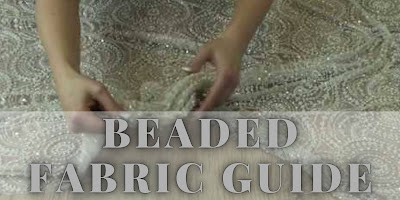A Beaded Lace Fabric is created by Beading small beads on a knitted fabric. Beaded Fabrics are used for making evening wear and special event dresses. Beads of different sizes, shapes, colors, and textures are used on Beaded Fabrics to create elaborate patterns that look like stitches or patterns on the dress. Beaded fabrics can range from very simple designs to extremely intricate designs with pearls, gems, and other embellishments on the fabric. Beads generally come in three major categories - Bicone (Discoid), Toho (Seed), and Magatama (Pearl).
BICONE BEADS: Bicone beads or discoid beads are shaped like two cones stuck together, with a round cap on the top. Bicone beads are most commonly used in Beading Beaded Fabrics because of their uniform size and shape, which is the smallest diameter possible for Beads. Bicone Beads also have very sharp edges that hold onto thread firmly, preventing Fabric from tearing apart easily.
TOHO BEADS: Toho or seed beads are named after one of the first Bead manufacturers. They are roughly teardrop-shaped (narrow at both ends) and resemble tiny beans (tohos). The sizes of Toho Beads generally start with sizes as small as 2mm up to 15mm. With bead weaving becoming increasingly popular, Toho Beads now come in a larger variety of shapes, sizes and surfaces. Toho Beads are very lightweight Beads that are used to create delicate patterns on Beaded Fabrics.
MAGATAMA BEADS: Magatama Beads are popularly known as pearl Beads but they are actually spherical Bicone Beads with the smallest possible diameter for Beads. They look very similar to pearls but can be distinguished by their uniform size and shape which is more consistent than pearls. Magatama Beads have a cylindrical hole through them making them easy to string onto thread while pearls don't have holes. Magatama Beads come in various colors & finishes including matte, shiny or metallic Beads. Beaded Fabrics Beaded with Magatama Beads are similar to Beaded Fabrics Beaded with pearls, however, the latter generally has a more luxurious look & feel compared to Bicone or Toho Beads.
Seed Beads come in many shapes and sizes depending on their use, but they all have a similar appearance - a small opaque bead that is slightly bigger than a pinhead. These Beads are used extensively for stringing by both those new to beadwork as well as experienced beaders because of their uniformity and value. Bugle beads - bugles Beads resemble large crystals but are actually long tubes made from glass or plastic. They are Beaded on the fabric Bead by Bead in a straight line or Braid. Bicone Beads are shaped like two cones with their points stuck together, covered with small round caps at the top. Bicone Beads are most commonly used in Beading Beaded Fabrics because of their uniform size and shape, which is the smallest diameter possible for Beads.

Comments
Post a Comment